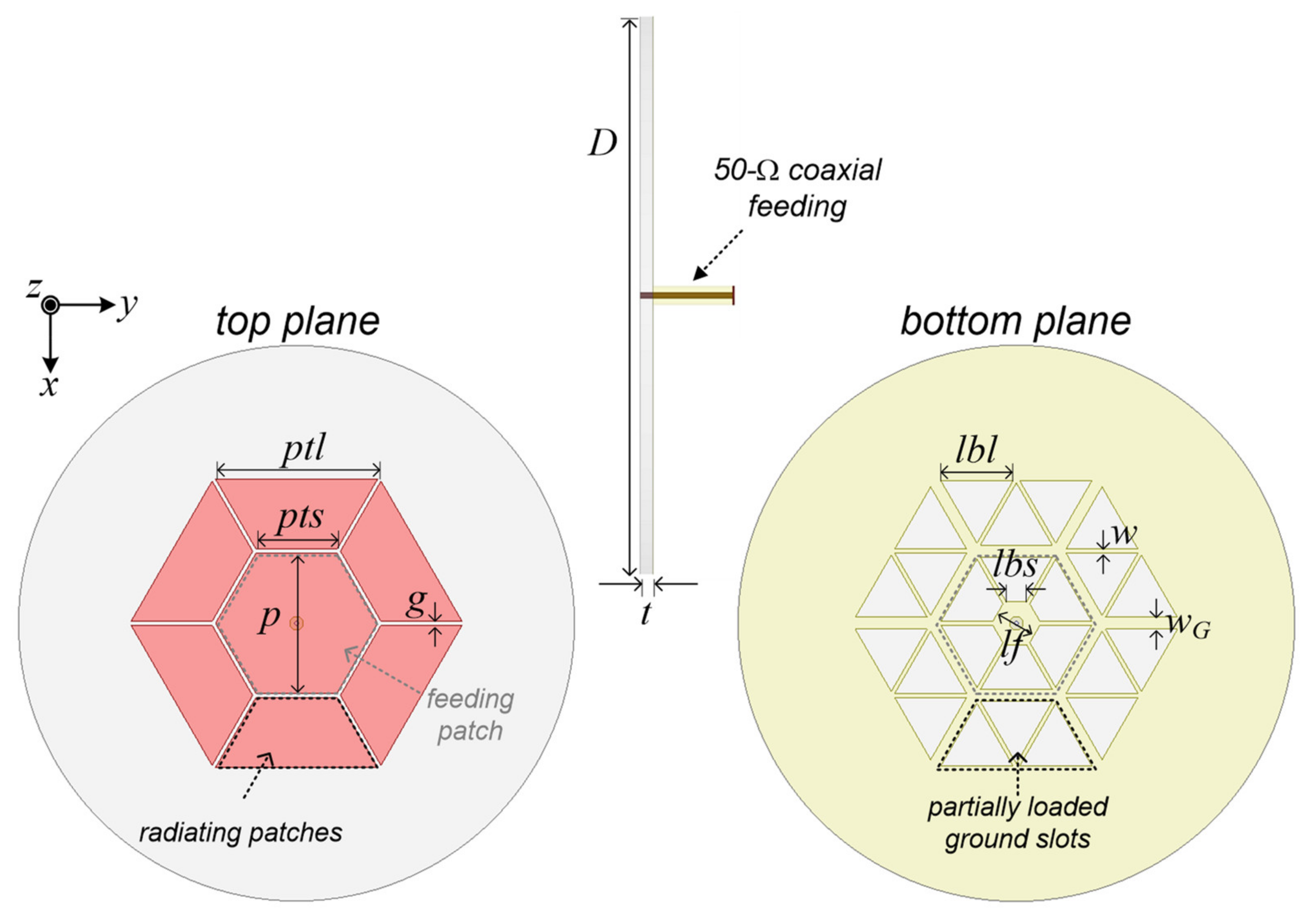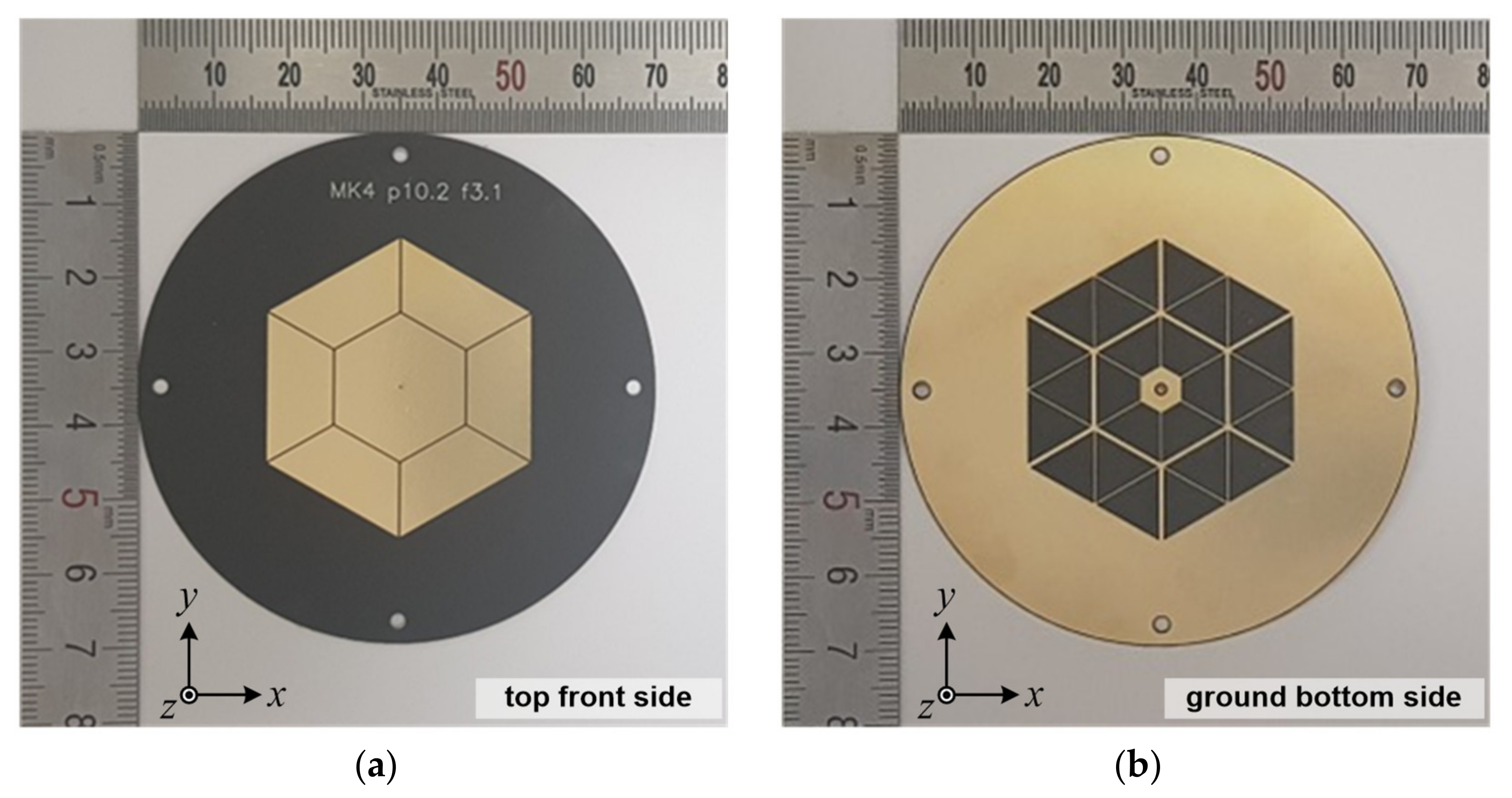Extremely Low-Profile Monopolar Microstrip Antenna with Wide Bandwidth
Abstract
:1. Introduction
2. Antenna Design and Analysis
2.1. Antenna Configuration
2.2. Operation Principle and Field Distributions
2.3. Parametric Analysis
3. Implementation and Measurement Results
4. Conclusions
Author Contributions
Funding
Institutional Review Board Statement
Informed Consent Statement
Data Availability Statement
Conflicts of Interest
References
- Zeng, W.; He, Y.; Li, B.; Wang, S. 3D Multiple-Antenna Channel Modeling and Propagation Characteristics Analysis for Mobile Internet of Things. Sensors 2021, 21, 989. [Google Scholar] [CrossRef] [PubMed]
- Ramos, A.; Varum, T.; Matos, J.N. Compact N-Band Tree-Shaped Multiplexer-Based Antenna Structures for 5G/IoT Mobile Devices. Sensors 2020, 20, 6366. [Google Scholar] [CrossRef] [PubMed]
- Yu, Y.; Mroueh, L.; Martins, P.; Vivier, G.; Terré, M. Radio Resource Dimensioning for Low Delay Access in Licensed OFDMA IoT Networks. Sensors 2020, 20, 7173. [Google Scholar] [CrossRef] [PubMed]
- Wu, F.; Rüdiger, C.; Yuce, M.R. Real-Time Performance of a Self-Powered Environmental IoT Sensor Network System. Sensors 2017, 17, 282. [Google Scholar] [CrossRef] [Green Version]
- Agiwal, M.; Roy, A.; Saxena, N. Next Generation 5G Wireless Networks: A Comprehensive Survey. IEEE Commun. Surveys Tuts. 2016, 18, 1617–1655. [Google Scholar] [CrossRef]
- Liu, Y.; Qin, Z.; Elkashlan, M.; Ding, Z.; Nallanathan, A.; Hanzo, L. Nonorthogonal Multiple Access for 5G and Beyond. Proc. IEEE 2017, 105, 2347–2381. [Google Scholar] [CrossRef] [Green Version]
- Wong, H.; So, K.K.; Gao, X. Bandwidth Enhancement of a Monopolar Patch Antenna with V-Shaped Slot for Car-to-Car and WLAN Communications. IEEE Trans. Veh. Technol. 2016, 65, 1130–1136. [Google Scholar] [CrossRef]
- Abboud, K.; Omar, H.A.; Zhuang, W. Interworking of DSRC and Cellular Network Technologies for V2X Communications: A Survey. IEEE Trans. Veh. Technol. 2016, 65, 9457–9470. [Google Scholar] [CrossRef]
- Gao, S.; Ge, L.; Zhang, D.; Qin, W. Low-Profile Dual-Band Stacked Microstrip Monopolar Patch Antenna for WLAN and Car-to-Car Communications. IEEE Access 2018, 6, 69575–69581. [Google Scholar] [CrossRef]
- Nguyen-Trong, N.; Piotrowski, A.; Kaufmann, T.; Fumeaux, C. Low-Profile Wideband Monopolar UHF Antennas for Integration Onto Vehicles and Helmets. IEEE Trans. Antennas Propag. 2016, 64, 2562–2568. [Google Scholar] [CrossRef]
- Chen, S.; Hu, J.; Shi, Y.; Zhao, L. LTE-V: A TD-LTE-Based V2X Solution for Future Vehicular Network. IEEE Internet Things J. 2016, 3, 997–1005. [Google Scholar] [CrossRef]
- Chen, S.; Hu, J.; Shi, Y.; Peng, Y.; Fang, J.; Zhao, R.; Zhao, L. Vehicle-to-Everything (v2x) Services Supported by LTE-Based Systems and 5G. IEEE Commun. Stand. Mag. 2017, 1, 70–76. [Google Scholar] [CrossRef]
- Motlagh, N.H.; Bagaa, M.; Taleb, T. UAV-Based IoT Platform: A Crowd Surveillance Use Case. IEEE Commun. Mag. 2017, 55, 128–134. [Google Scholar] [CrossRef] [Green Version]
- Zhang, S.; Zhang, H.; Di, B.; Song, L. Cellular UAV-to-X Communications: Design and Optimization for Multi-UAV Networks. IEEE Trans. Wireless Commun. 2019, 18, 1346–1359. [Google Scholar] [CrossRef] [Green Version]
- Wang, X.; Yadav, V.; Balakrishnan, S.N. Cooperative UAV Formation Flying with Obstacle/Collision Avoidance. IEEE Trans. Control Syst. Technol. 2007, 15, 672–679. [Google Scholar] [CrossRef]
- Anim, K.; Lee, J.-N.; Jung, Y.-B. High-Gain Millimeter-Wave Patch Array Antenna for Unmanned Aerial Vehicle Application. Sensors 2021, 21, 3914. [Google Scholar] [CrossRef] [PubMed]
- Hayat, S.; Yanmaz, E.; Muzaffar, R. Survey on Unmanned Aerial Vehicle Networks for Civil Applications: A Communications Viewpoint. IEEE Commun. Surv. Tuts. 2016, 18, 2624–2661. [Google Scholar] [CrossRef]
- Rodríguez-Osorio, R.M.; Ramírez, E.F. A Hands-On Education Project: Antenna Design for Inter-CubeSat Communications [Education Column]. IEEE Antennas Propag. Mag. 2012, 54, 211–224. [Google Scholar] [CrossRef] [Green Version]
- Radhakrishnan, R.; Edmonson, W.W.; Afghah, F.; Rodriguez-Osorio, R.M.; Pinto, F.; Burleigh, S.C. Survey of Inter-Satellite Communication for Small Satellite Systems: Physical Layer to Network Layer View. IEEE Commun. Surv. Tuts 2016, 18, 2442–2473. [Google Scholar] [CrossRef] [Green Version]
- James, J.R.; Hall, P.S.; Wood, C. Microstrip Antenna Theory and Design; Peter Peregrinus: London, UK, 1981; Volume 1. [Google Scholar]
- Garg, R.; Bahl, P.; Ittipiboon, A. Microstrip Antenna Design Handbook; Artech House: Dedham, MA, USA, 2001. [Google Scholar]
- Zaid, J.; Abdulhadi, A.E.; Denidni, T.A. Miniaturized Multi-Port Microstrip Patch Antenna Using Metamaterial for Passive UHF RFID-Tag Sensor Applications. Sensors 2019, 19, 1982. [Google Scholar] [CrossRef] [Green Version]
- Burberry, B.A.; Foster, P.R. New Kind of Microstrip Antenna: The Monopolar Wire Patch Antenna. Electron. Lett. 1994, 30, 745. [Google Scholar] [CrossRef]
- Al-Zoubi, A.; Yang, F.; Kishk, A. A Broadband Center-Fed Circular Patch-Ring Antenna with a Monopole Like Radiation Pattern. IEEE Trans. Antennas Propag. 2009, 57, 789–792. [Google Scholar] [CrossRef]
- Liu, J.; Xue, Q.; Wong, H.; Lai, H.W.; Long, Y. Design and Analysis of a Low-Profile and Broadband Microstrip Monopolar Patch Antenna. IEEE Trans. Antennas Propag. 2013, 61, 11–18. [Google Scholar] [CrossRef]
- Liu, J.; Zheng, S.; Li, Y.; Long, Y. Broadband Monopolar Microstrip Patch Antenna with Shorting Vias and Coupled Ring. IEEE Antennas Wirel. Propag. Lett. 2014, 13, 39–42. [Google Scholar] [CrossRef]
- Caloz, C.; Itoh, T. Electromagnetic Metamaterials; Wiley: New York, NY, USA, 2006. [Google Scholar]
- Lai, A.; Leong, K.M.K.H.; Itoh, T. Infinite Wavelength Resonant Antennas with Monopolar Radiation Pattern Based on Periodic Structures. IEEE Trans. Antennas Propag. 2007, 55, 868–876. [Google Scholar] [CrossRef]
- Lee, J.-G.; Lee, J.-H. Zeroth Order Resonance Loop Antenna. IEEE Trans. Antennas Propag. 2007, 55, 994–997. [Google Scholar] [CrossRef]
- Pyo, S.; Han, S.-M.; Baik, J.-W.; Kim, Y.-S. A Slot-Loaded Composite Right/Left-Handed Transmission Line for a Zeroth-Order Resonant Antenna with Improved Efficiency. IEEE Trans. Microw. Theory Tech. 2009, 57, 2775–2782. [Google Scholar] [CrossRef]
- Lee, D.; Kim, K.; Pyo, S. Mesh-Grounded Monopolar Hexagonal Microstrip Antenna for Artillery-Launched Observation Round. Electronics 2019, 8, 1279. [Google Scholar] [CrossRef] [Green Version]
- Hong, J.-S.; Lancaster, M.J. Microstrip Filters for RF/Microwave Applications; John Wiley & Sons, Inc.: New York, NY, USA, 2001. [Google Scholar]
- Zhu, X.-Q.; Guo, Y.-X.; Wu, W. A Novel Dual-Band Antenna for Wireless Communication Applications. IEEE Antennas Wirel. Propag. Lett. 2016, 15, 516–519. [Google Scholar] [CrossRef]
- Lawrence, N.P.; Fumeaux, C.; Abbott, D. Planar Triorthogonal Diversity Slot Antenna. IEEE Trans. Antennas Propag. 2017, 65, 1416–1421. [Google Scholar] [CrossRef]
- Nguyen-Trong, N.; Ta, S.X.; Ikram, M.; Bertling, K.; Abbosh, A.M. A Low-Profile Wideband Tripolarized Antenna. IEEE Trans. Antennas Propag. 2019, 67, 1946–1951. [Google Scholar] [CrossRef]
- Ta, S.X.; Nguyen-Thi, D.; Nguyen, K.K.; Dao-Ngoc, C.; Nguyen-Trong, N. Design of a Low-Profile Tripolarized Antenna with Wide Bandwidth. IEEE Access 2019, 7, 82701–82708. [Google Scholar] [CrossRef]
- Zhang, H.-F.; Liu, G.-B.; Zeng, L.; Huang, T. Design of a tunable omnidirectional circularly polarized antenna based on VO2. Int. J. RF Microw. Comput. Aided Eng. 2020, 30, e21997. [Google Scholar] [CrossRef]
- Zhao, Z.-H.; Zhang, H.-F. A wide-band circularly polarized antenna array using a sequential phase feed structure applied to 5G-band. J. Electromagn. Waves Appl. 2021. [Google Scholar] [CrossRef]








| Variables | Description | Dimension (mm) |
|---|---|---|
| p | Length of the feeding hexagonal patch | 17.7 |
| pts | Upper length of the radiating trapezoidal patch | 10.2 |
| ptl | Lower length of the radiating trapezoidal patch | 20.4 |
| g | Coupling gap size between feed and radiator | 0.2 |
| w | GND wire width occurred from inner radiator | 0.2 |
| wG | GND wire width occurred from between radiator | 0.6 |
| lf | Soldering pad length of the feed in the GND | 9.7 |
| lbs | GND slot length of the upper side of trapezoid | 5.4 |
| lbl | GND slot length of the equilateral triangle | 2.9 |
| D | Diameter of the substrate | 70 |
| t | Thickness of the substrate | 0.254 |
| Ref., Work Year | Ground Size, mm2 (/λmin 1) | Height, mm (/λmin 1) | BW(%) | Antenna Type |
|---|---|---|---|---|
| [30], 2009 | 35 × 35 | 0.76 | 0.7% | Zeroth-Order Resonant |
| (0.502 × 0.502) | (0.011) | |||
| [7], 2016 | π × 32 × 32 | 3 | 32.2% | Monopolar Microstrip |
| π × (0.514 × 0.514) | (0.048) | |||
| [33], 2016 | π × 30.8 × 30.8 | 6.3 | 15.4% | Monopolar Microstrip |
| π × (0.572 × 0.572) | (0.117) | |||
| [10], 2019 | π × 80 × 80 | 10 | 12.7% | Monopolar Microstrip |
| π × (0.987 × 0.987) | (0.123) | |||
| [34], 2017 | π × 130 × 130 | 3.18 | 2.3% | Tripolarized Monopolar Microstrip |
| π × (2.5 × 2.5) | (0.08) | |||
| [35], 2019 | π × 113 × 113 | 10.508 | 14.0% | Tripolarized Monopolar Microstrip |
| π × (0.859 × 0.859) | (0.08) | |||
| [36], 2019 | π × 120 × 120 | 9.2 | 24.45% | Tripolarized Monopolar Microstrip |
| π × (0.876 × 0.876) | (0.07) | |||
| [31], 2019 | π × 35 × 35 | 1.6 | 7.78% | Monopolar Microstrip |
| π × (0.651 × 0.651) | (0.03) | |||
| This Work | π × 35(0.651) × 35(0.651) | 0.254 | 15.24% | Monopolar Microstrip |
| (0.0044) |
Publisher’s Note: MDPI stays neutral with regard to jurisdictional claims in published maps and institutional affiliations. |
© 2021 by the authors. Licensee MDPI, Basel, Switzerland. This article is an open access article distributed under the terms and conditions of the Creative Commons Attribution (CC BY) license (https://creativecommons.org/licenses/by/4.0/).
Share and Cite
Ha, Y.; Jung, J.-i.; Lee, S.; Pyo, S. Extremely Low-Profile Monopolar Microstrip Antenna with Wide Bandwidth. Sensors 2021, 21, 5295. https://doi.org/10.3390/s21165295
Ha Y, Jung J-i, Lee S, Pyo S. Extremely Low-Profile Monopolar Microstrip Antenna with Wide Bandwidth. Sensors. 2021; 21(16):5295. https://doi.org/10.3390/s21165295
Chicago/Turabian StyleHa, Youngseok, Jae-il Jung, Sunghee Lee, and Seongmin Pyo. 2021. "Extremely Low-Profile Monopolar Microstrip Antenna with Wide Bandwidth" Sensors 21, no. 16: 5295. https://doi.org/10.3390/s21165295
APA StyleHa, Y., Jung, J.-i., Lee, S., & Pyo, S. (2021). Extremely Low-Profile Monopolar Microstrip Antenna with Wide Bandwidth. Sensors, 21(16), 5295. https://doi.org/10.3390/s21165295






